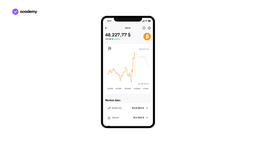The Cryptocurrency Market: How to Read Basic Market Data
October 4, 2021
7 min

If you want to start analysing the cryptocurrency market and read its price with the right outlook, you should know that cryptocurrencies do not have the same market data as financial instruments, as they are not considered actual financial instruments by the authorities.
On Young Platform and Young Platform Step, you can view market data for all supported cryptocurrencies on each cryptocurrency’s focus page.
Let’s start from the beginning.
1. Circulating Supply
As we know, every cryptocurrency has a market supply, which is measured by the Circulating Supply.
According to its tokenomics, the cryptocurrency will also have a predetermined total supply and possibly a maximum supply.
Total Supply is the entirety of existing cryptocurrency units, not necessarily available on the market. Circulating Supply, on the other hand, represents only those coins or tokens that have already been released onto the cryptocurrency market.
So it includes the amounts on all the world’s wallets and tokens available for trading.
The difference between Total Supply and Circulating Supply is those coins that the protocol has already created and that are held in a wallet managed according to the project’s governance.
Maximum supply, on the other hand, is not specified for all cryptocurrencies. It indicates the maximum number of units that can ever exist, thus expressing a limit to the inflation of the coin.
Bitcoin for example has a maximum supply of 21 million bitcoins. This means that no more than 21 million BTC can ever be mined.
What’s interesting about that?
Supply is simply the other side of scarcity. The scarcer a good is, the more valuable it is on the market, as people will be willing to pay more for it in order to have something “rare”.
This does not mean that if there are only 200 tokens of a cryptocurrency, it will work better. There must be enough units to make the currency widespread and therefore usable and available, but not so many as to nullify its purchasing power.
2. Market Cap
Market Capitalisation, a.k.a. Market Cap, is a figure derived directly from the price multiplied by the circulating supply.
The market cap, therefore, indicates the market value of all units of a cryptocurrency in circulation.
If you want to know how much a cryptocurrency is worth, how important it is, you don’t have to look at the price, but at the market cap.
What’s interesting about that?
Looking at the market cap of the top three cryptocurrencies can give us a sense of, for example, how much relevance Bitcoin and Ethereum have in the market compared to the altcoins below them.
The two queens are worth hundreds of billions, while the best following ones are worth tens of billions (at the end of 2021).
Fully Diluted Market Cap
A close cousin of the market cap is the Fully Diluted Market Cap, which not all sites indicate because it is purely theoretical. This is in fact the result of the multiplication between price and total supply.
It indicates the market value that the currency would have if all its units were already in circulation. We know very well that when this actually happens, the price of the currency could vary 10, 50, 100 times.
However, it is interesting to make assumptions about the future, knowing the future supply of a currency and combining it with price forecasts.
3. Dominance
The purpose of dominance is precisely to represent the market relevance of a cryptocurrency with an immediately readable figure.
Again, the mathematics are very trivial.
Dominance is simply the percentage that the market cap of a cryptocurrency represents compared to the market cap of the entire cryptocurrency market.
Example:
The market cap of the world’s top 12,282 cryptocurrencies is estimated at $2,114,644,421,248.
If Bitcoin’s market cap instead is $899,483,699,724, we will know its dominance by solving the following proportion:
899.483.699.724$ : 2.114.644.421.248$ = x : 100
Then
Dominance of Bitcoin = MC BTC * 100/ MC tot
Bitcoin’s market dominance is in fact currently 42.5%.
What’s interesting about that?
Just think that from January 2021 to September 2021, Bitcoin’s dominance fell from 71% to 42%.
At the same time, Ethereum went from 11% to 20%. The aggregate dominance of Bitcoin and Ethereum thus fell from 82% to 62%. This means that other altcoins have slowly grown and come slightly closer to the brilliance of Digital Gold.
In particular, this could be a symptom of the DeFi protocol tokens born from the summer of 2020 onwards, which have been growing rapidly from month to month, making the top of the cryptocurrency market more diverse and richer.
4. Volume 24h
“Volume” in this context refers to the amount of cryptocurrency sold and bought over a period.
At Young Platform we use the 24-hour period to give a sense of supply and demand on a day-to-day basis.
Volume is usually expressed in fiat. It is the sum of the amounts of all sales and purchases of a cryptocurrency, converted into euros or dollars.
What’s interesting about that?
Market sentiment indices, for example, are based on trading volumes. These associate buying and selling volumes with emotions such as fear or enthusiasm of traders.
Volume is also directly linked to the liquidity of an asset. When there are high purchase volumes, and therefore demand, the asset acquires liquidity, and is therefore easier to spend.
Liquidity is a fundamental property for an asset and for a cryptocurrency that wants to be widely adopted.
5. ROI
Return on Investment is a measure used to assess the performance of cryptocurrency or to compare it to others. Specifically, it measures the return on a cryptocurrency in relation to its cost at the time of purchase(s).
I can calculate the ROI I have already made on a cryptocurrency, or the ROI estimated by special sites for a future purchase.
To calculate the ROI, simply divide the profit (or return) made from a sale by its cost at the time of purchase. The result is expressed as a percentage by the ROR (rate of return).
This value is also used at the analysis stage, before buying, to get an impression of the return on an asset.
On sites dedicated to market data, you will find this value calculated on the price at launch of the cryptocurrency.
In this case, the ROI provided does not take into account the current cryptocurrency market, and should therefore be put into context.
Example:
The first price available on Coinmarketcap for Bitcoin is around $100 in 2014. Let’s calculate how much you would have earned by buying 1BTC at $100 and only selling in 2021 at $47500.
The formula is ROI = (Current cost – Initial cost)/Initial cost
ROI = 474
In percentage it is a gain of +47400% (ROR).
What’s interesting about that?
Like any value or indicator, ROI should not be taken as the only parameter in deciding which cryptocurrency to buy. We can, however, have fun fantasising about possible lives in which we could have been early adopters and later majestic whales. Will there ever be another possibility?



